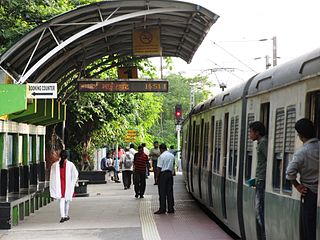
The Kolkata Suburban Railway is a set of suburban and regional rail services serving the Kolkata metropolitan area and its surroundings in India. It is the largest suburban railway network in the country by number of stations and track length, and also one of the largest in the world. There are five main lines and nineteen branch lines. It operates more than 1,500 services, carrying 3.5 million people daily and 1.2 billion people every year. It runs from 03:00 am until 02:00 am and fares range from Rs.5 to Rs.25. The system uses 25 kV 50 Hz AC power supply and runs on 5 ft 6 in broad gauge track. It has interchange stations with the Kolkata Metro at various locations.

Barddhaman Junction Railway Station is a railway junction station on the Howrah–Delhi main line and is located in Purba Bardhaman District in the Indian state of West Bengal. EMU services from Howrah along Howrah–Bardhaman main line and Howrah–Bardhaman chord terminate at Bardhaman. Every day, over 300 express/mail/SF trains halt here, making it one of the busiest and important junction railway station in Eastern India. It serves Bardhaman, the fifth most populous city in West Bengal.

Seoraphuli Junction railway station is a Kolkata Suburban Railway station on the Howrah–Bardhaman main line in Hooghly district in the Indian state of West Bengal. It serves Sheoraphuli area & northern part of the Serampore City. The Sheoraphuli–Tarakeswar branch line meets Howrah–Bardhaman main line at Sheoraphuli.

Solapur railway station is located in Solapur district in the Indian state of Maharashtra and serves Solapur city and the industrial belt around it. It is headquarters of Solapur Railway Division and a part of Central Railway zone.

The Mumbai–Chennai line, earlier known as Bombay–Madras line, is a railway line connecting Chennai and Mumbai cutting across southern part of the Deccan Plateau. It covers a distance of 1,281 kilometres (796 mi) across Maharashtra, Karnataka, Telangana, Andhra Pradesh and Tamil Nadu. The Mumbai–Chennai line is a part of Diamond Quadrilateral.

Adisaptagram railway station is a Kolkata Suburban Railway station on the Howrah–Bardhaman main line operated by Eastern Railway zone of Indian Railway. It is situated beside S.T. Road, Adisaptagram, Trishbigha in Hooghly district in the Indian state of West Bengal. It serves Saptagram and surrounding areas such as Debanandapur, Kestopur etc. Number of EMU stop at Adisaptagram railway station.

Mogra railway station is a Kolkata Suburban Railway station on the Howrah–Bardhaman main line operated by Eastern Railway zone of Indian Railway. It is situated beside Polba Road, Alikhoja, Mogra in Hooghly district in the Indian state of West Bengal. All EMU and passenger trains stops at Mogra railway station. The construction work of third line between Bandel and Bardhaman is completed for which a new platform(1) is created. Mogra-Katwa line connecting Magra on Howrah–Bardhaman Main line with Tribeni on Bandel–Katwa line is also there. As of now it is only use for goods train transport. Another line from Tarwakeshwar to Magra via Dhaniakhali is also in development. Magra will be transferred to Magra Junction soon after the development of the Magra-Tarakeshwar line via Dhaniakhali. Lands for the new Magra-Tarakeshwar line are brought by the government and it is also in development.

Talandu railway station is a Kolkata Suburban Railway station on the Howrah–Bardhaman main line operated by Eastern Railway zone of Indian Railways. It is situated beside Talandu – Sultangacha Road, Bharatpur in Hooghly district in the Indian state of West Bengal.
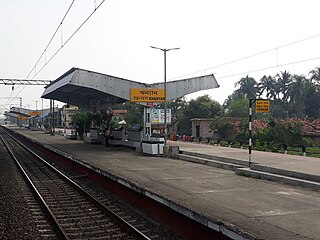
Khanyan railway station is a Kolkata Suburban Railway station on the Howrah–Bardhaman main line operated by Eastern Railway zone of Indian Railways. It is situated beside Polba-Khanyan Road at Khanyan in Hooghly district in the Indian state of West Bengal.

Pundooah railway station is a Kolkata Suburban Railway station on the Howrah–Bardhaman main line operated by Eastern Railway zone of Indian Railways. It is situated beside Station Road at Pandua in Hooghly district in the Indian state of West Bengal. Number of EMU and passenger trains stop at Pundooah railway station. The distance between Howrah and Pundooah railway station is approximately 61 km.
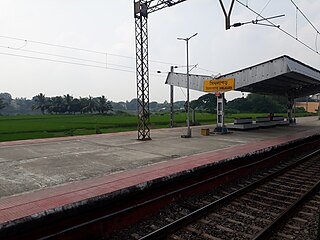
Simlagarh railway station is a Kolkata Suburban Railway station on the Howrah–Bardhaman main line operated by Eastern Railway zone of Indian Railways. It is situated beside Talbona Colony Road, National Highway 2 at Simlagarh in Hooghly district in the Indian state of West Bengal. The distance between Howrah and Simlagarh railway station is approximately 65 km.
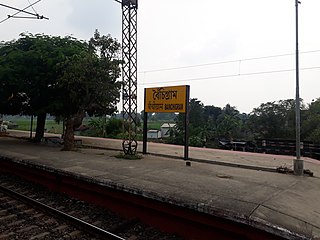
Bainchigram railway station is a Kolkata Suburban Railway station on the Howrah–Bardhaman main line operated by Eastern Railway zone of Indian Railways. It is situated beside Grand Trunk Road at Bainchigram in Hooghly district in the Indian state of West Bengal.

Bainchi railway station is a Kolkata Suburban Railway station on the Howrah–Bardhaman main line operated by Eastern Railway zone of Indian Railways. It is situated at Boinchi in Hooghly district in the Indian state of West Bengal. Number of EMU and passengers trains stop at this railway station. The distance between Howrah to Bainchi railway station is approximately 70 km.
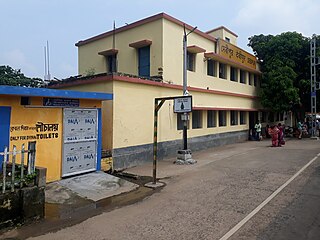
Debipur railway station is a Kolkata Suburban Railway station on the Howrah–Bardhaman main line operated by Eastern Railway zone of Indian Railways. It is situated beside National Highway 2 at Debipur, Purba Bardhaman district in the Indian state of West Bengal.

Bagila railway station is a Kolkata Suburban Railway station on the Howrah–Bardhaman main line operated by Eastern Railway zone of Indian Railways. It is situated beside National Highway 2 at Kalshi, Bagila, Purba Bardhaman district in the Indian state of West Bengal. Number of EMU trains stop at Bagila railway station.
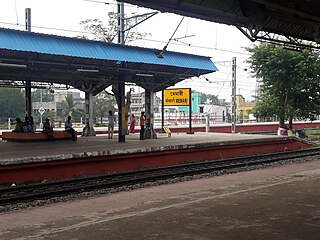
Memari railway station is a Kolkata Suburban Railway station on the Howrah–Bardhaman main line operated by Eastern Railway zone of Indian Railways. It is situated beside National Highway 2 at Memari, Purba Bardhaman district in the Indian state of West Bengal. Number of EMU and passenger trains stop at Memari railway station.
Nimo railway station is a Kolkata Suburban Railway Halt station on the Howrah–Bardhaman main line operated by Eastern Railway zone of Indian Railways. It is situated at Nimo, Purba Bardhaman district in the Indian state of West Bengal.

Rasulpur railway station is a Kolkata Suburban Railway station on the Howrah–Bardhaman main line operated by Eastern Railway zone of Indian Railways. It is situated beside Rasulpur – Kuchut Road at Baidyadanga, Rasulpur, Purba Bardhaman district in the Indian state of West Bengal.
Palsit railway station is a Kolkata Suburban Railway station on the Howrah–Bardhaman main line operated by Eastern Railway zone of Indian Railways. It is situated beside Palla Road, National Highway 2, at Sekhpur, Palsit, Purba Bardhaman district in the Indian state of West Bengal.

Gangpur railway station is a Kolkata Suburban Railway station on the Howrah–Bardhaman main line operated by Eastern Railway zone of Indian Railways. It is situated at Jotram, Nirankari Colony, Gangpur, Purba Bardhaman district in the Indian state of West Bengal.


















